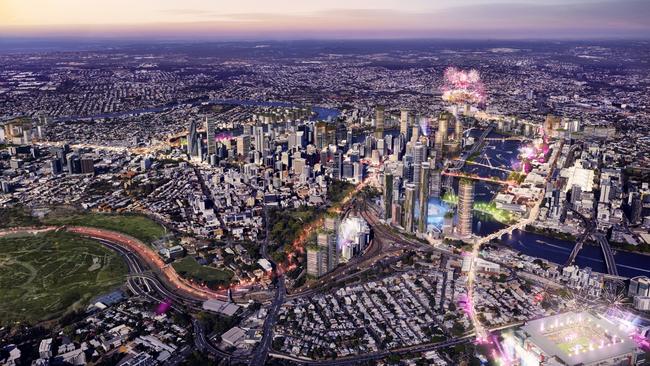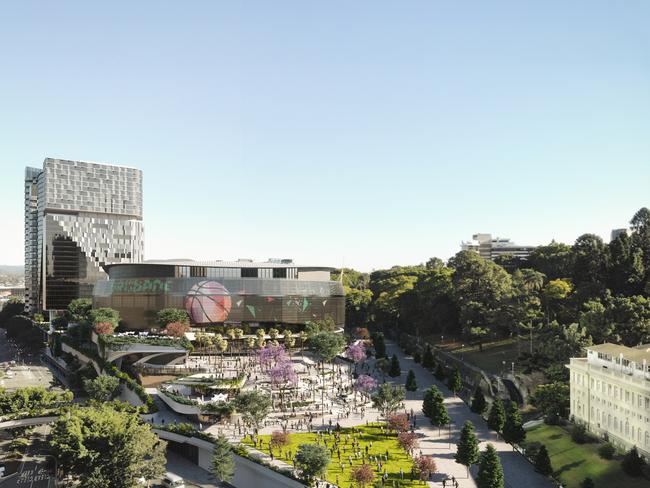Future Brisbane: ‘Greenways’ to help city beat the heat
As Brisbane gets warmer in the run-up to the 2032 Games, redesigning the city around keeping our cool will be key.

Future QLD
Don't miss out on the headlines from Future QLD. Followed categories will be added to My News.
Embracing Brisbane’s subtropical climate and linking the city’s lush parklands with “greenways” is key to elevating the city’s liveability in the coming years – and beating the hot weather battle.
University of Queensland professor Peter Hyland said dealing with the reality of climate change – and that Brisbane was likely to get even warmer over the next decade – was crucial.
Brisbane has been consistently marked down on environment in The Economist’s liveability rankings due to its warm and humid weather.
While the weather can’t be changed, Prof Hyland – an industry fellow at UQ’s School of Architecture, Design and Planning – said the worst outcome as more of the city’s major precincts were linked by a planned loop was to have them connected by giant concrete walkways.
Instead, making “greenways” such as paths adorned with foliage, solar panels and shade was a better solution to keep them pleasant and more likely to be used in the hot summer months.
“Brisbane is very well served in terms of green spaces and parklands – the next step is linking them all together,” he said.
“There are plans to create an almost 9km walking loop between the Olympic venues – passing through the Botanic Gardens, South Bank, Roma Street – and we want to make the journey between them pleasant.

“We’re very lucky to live in this subtropical climate, so we can have trees, we can have vegetation.
“We are dealing with the reality of climate change, and we are going to have more extremes and hotter weather.
“We’ve got to be able to plan ahead, and think and design our spaces and places to ensure they do support the environment.”
But Prof Hyland defended the controversial King George Square, which has often been named by critics as a place with too much concrete and not enough greenery following the redevelopment by then lord mayor Campbell Newman about 15 years ago.
“King George Square serves its purpose. If you look at any great city – London’s Trafalgar Square, Plaza Mayor in Madrid – they all have a great square, a civic gathering place where you have the ability to bring people together,” he said.
One place with plenty of green was Brisbane hotspot Howard Smith Wharves, which as attracted an astonishing 20 million visitors through its precinct since it opened five years ago.
Chief executive Luke Fraser said looking at the bustling spot, it was difficult to believe in just a short time it had been transformed from a place which was basically inaccessible.
“Now, we have people run through on their morning exercise route, cycling to work, having lunch on the lawn and people enjoying the sunset at the end of the day,” he said.
“We’re proud to have created a space that is enjoyed by people across the city and contributes towards a new standard of liveability.

“It’s great that Brisbane is reimagining the use of our outdoor spaces, making the most of the climate that we all enjoy.”
Describing the Brisbane River as the city’s “superpower”, Mr Fraser said harnessing the city’s waterway would only further increase green spaces for locals and visitors to enjoy.
“Green spaces play an essential role not only for the built environment and our city but also for community wellbeing,” he said.
“We’re proud to integrate and harness the power and beauty of the natural environment around us to enhance locals and visitors’ experiences down at Howard Smith Wharves and to celebrate our beautiful city.”
Prof Hyland said he was confident the city’s urban designers recognise “both the challenges, but also the opportunities” of transforming Brisbane into a new world city.
“We’re seeing that in the new buildings as well. Aria do great work, down at Waterfront Dexus they area creating a really attractive green space for people to pass through, and South Bank with its new masterplan will see its green areas increase.”
Ensuring we get this right encourages people to get outside more and be more active, Prof Hyland said.
“It also makes for a more connected community,’ he said.
“If everyone just stays inside and sits in their aircon, you lose that sense of connection.”




